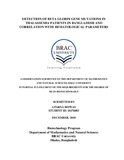Detection of beta globin gene mutations in thalassemia patients in Bangladesh and correlation with hematological parameters
Abstract
β-thalassemia and hemoglobin E (Hb E) diseases are highly prevalent autosomal recessive disorders characterized by the reduced or absent expression of the β globin gene. β-thalassemia is now regarded as the most common inherited single gene disorder in the world including Bangladesh. Like β-thalassemia, Hb E disorder is also supposed to be highly prevalent in Bangladesh. Around 4.1 % of total populations are carriers of beta thalassemia and 6.1% are carriers of Hemoglobin-E beta thalassemia (Hb-EBT) in Bangladesh. Around three hundred thousand infants are born with Thalassemia worldwide each year and more than 270 million people are carriers of Thalassemia. It has been estimated by Hardy-Weinberg equation that approximately 8990 beat-thalassemia babies are being born each year in Bangladesh. Individuals with beta-thalassemia major (BTM) suffer from severe anemia, growth retardation, splenomegaly, jaundice, expansion of bone-marrow, bone deformities and require blood transfusion to avoid complications. The aim of the present study is to identify the common mutations of beta-globin gene and to establish any possible correlation with hematological parameters and with blood transfusion interval of the patients which is the indicator of disease severity of the thalassemia patients. A total of 60 transfusion dependent thalassemia patients were enrolled for the study from Dhaka Shishu Hospital. Among these patients, 31 (51.7%) and 29 (48.3%) patients were males and females, respectively. Complete blood count (CBC) and Hb-electrophoresis were performed to identify the type of beta-thalassemia patients. The mutations of beta-globin gene were detected by amplification of selective region of beta-globin gene using polymerase chain reaction (PCR) followed by automated Sanger’s DNA sequencing and BLAST method. Among 60 transfusion dependent thalassemia patients, 39 (65%) were suffering from Hb-EBT (EBT), whereas 21 (35%) patients had beta thalassemia major (BTM). Mutation analysis of beta-globin gene revealed 9 mutations, namely c.79 G>A, IVS-1-5 G>C, c.126-129 del_CTTT, IVS-I-130 G>C, c.47 G>A, c.33 delA, c.51delC, c. G92C and c.126delC. Further, we found lower level of RBC count, hematocrit, MCV and MCH compared to the respective reference values, whereas the mean RDW level and WBC count of the enrolled patients were higher than the reference range. The enrolled patients were divided into three groups based on their transfusion intervals, namely Group 1 (< 1 month), Group 2 (1 month to < 1.5 month) and Group 3 (> 1.5 months). One-way ANOVA test for hematocrit, Hb concentration, RBC count, MCV, MCH, RDW and WBC count among these three groups of patients had been performed. We found no statistically significant difference among these three groups in terms of percentages of hematocrit (ANOVA: p = 0.9973), MCHC (ANOVA: p = 0.0605), MCV (ANOVA: p = 0.0782), platelet count (ANOVA: p = 0.9710), RBC count (ANOVA: p = 0.3954) and WBC count (ANOVA: p = 0.7415) but there was statistically significant difference in terms of MCH (ANOVA: p = 0.0319) and RDW (ANOVA: p = 0.0020) value between Group 1 and Group 3 in our study. In conclusion, the data from our study clearly demonstrates that group 3 (less severe group) patients had higher MCH and RDW values compared to the Group 1 patients (most severe group).

